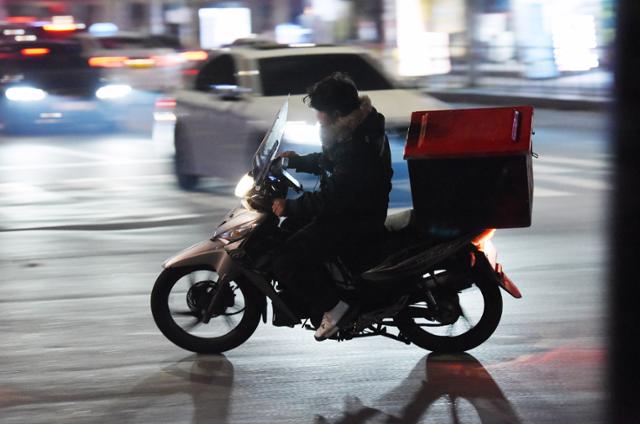[Mar] Pandemic changes Korea’s already-booming delivery industry
Date Mar 27, 2022
 Delivery man on a motorcycle in Goyang, Gyeonggi-do Province
Delivery man on a motorcycle in Goyang, Gyeonggi-do Province
Korea was the perfect test bed for new delivery services, due to its cutting-edge technology, dense population and abundance of food, groceries and other things to be delivered by hand. And then the pandemic struck early in 2020, flipping many industries upside-down – and the role of the delivery industry became ever more important.
Demand for home delivery services went up early in the pandemic, as people tried to minimize social contact by staying home more, and restaurants sought to sell dishes beyond curfew hours. Delivery drivers – traveling mostly by scooter, but also by car, truck and anything mobile – became front-line workers playing a huge role in keeping society together and enabling the economy to continue moving. Food delivery platforms sold 17.33 trillion won worth of food and beverages in 2020, nearly double the 9.74 trillion won sold the year before.
“We definitely felt a sense of mission during the start of the pandemic,” said Jason Boutte, co-founder of Shuttle Delivery, a Seoul-based delivery startup that specializes in food delivery, including groceries.
“We wanted to be of service to our community. We felt honestly relieved that we were bringing value to people. We were also more lucrative during the pandemic, too.”
Fear of infection turned people toward remote, online and non-face-to-face services, and the delivery companies responded. They looked for ways to reduce contact between their workers and customers. Shuttle and others went cash-free, requiring customers to pay in advance through various e-payment methods. Also, drivers would no longer wait for a customer to open a door and accept delivery. They offered “no contact” deliveries instead: a quick knock and run or a text message after the food was dropped off.
Restaurants changed as well, as they adapted to fulfilling delivery orders to make up for the drop in in-store customers. Many restaurants that pivoted to delivery services came up with pickup zones for delivery workers, so they could come and go quickly without interacting too closely with customers dining there. The pandemic also saw the opening of kitchens that primarily prepare delivery orders and shops where people can purchase pre-packed fresh ingredients with directions for how to fix popular meals like budae-jjigae and bulgogi at home.
As pandemic restrictions are easing and people are slowly returning to normal daily life, delivery companies and other businesses are expanding the services they offer. Besides prepared food from restaurant kitchens, some are also trying to roll out grocery delivery services. And others are making it easier to order take-out from restaurants for pickup, eliminating the need for delivery drivers altogether while continuing to limit face-to-face contact as much as possible.
“It was hard to keep up with the demand for drivers honestly,” Boutte said. “Our drivers were given a ton of respect while they were working every day.”
The future of the delivery market is a bit murky with social interaction resuming once more, but after two years of proven adaptability in the face of changing consumer needs, there should be no doubt that the local delivery industry has a bright future ahead of it.
**If you have any questions about this article, feel free to contact us at kocis@korea.kr.**

The Ministry of Culture, Sports and Tourism's "Korea Here & Now" work can be used under the condition of "Public Nuri Type 1 (Source Indication)."




